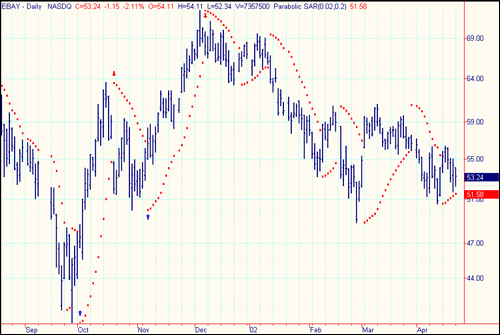Parabolic SAR
PARABOLIC SAR (PS)
used to find trends in market prices and securities
J. Welles Wilder Jr. devised the Parabolic Stop and Reverse (SAR) to find trends in market prices or securities. The method can be used as a trailing stop loss based on prices tending to stay within a parabolic curve during a strong trend.
The Working Idea
The working idea is that time is an enemy, and unless a security can continue to generate more profits over time, it should be sold. The indicator generally works well in trending markets, but provides “whipsaws” during non-trending, sideways phases; as such, Wilder recommended establishing the strength and direction of the trend first through the use of things such as the Average Directional Index (ADI), and then using the Parabolic SAR to trade that trend.
Constructing a Parabolic SAR
The Parabolic SAR is calculated almost independently for each trend in the price. When the price is in an uptrend, the SAR emerges below the price and converges upwards towards it. Similarly, on a downtrend, the SAR emerges above the price and converges downwards.
At each step within a trend, the SAR is calculated ahead of time. That is, tomorrow’s SAR value is built using data available today. The general formula used for this is:
SARn+1 = SARn + α ( EP – SARn )
Where SARn and SARn + 1 represent today’s and tomorrow’s SAR values, respectively.
EP (the extreme point) is a record kept during each trend that represents the highest value reached by the price during the current uptrend — or lowest value during a downtrend. During each period, if a new maximum (or minimum) is observed, the EP is updated with that value.
The α value represents the acceleration factor. Usually, this is set initially to a value of 0.02. This factor is increased by 0.02 each time a new EP is recorded. What this means is that everytime a new EP is observed, it will make the acceleration factor go up. The rate will then quicken to a point where the SAR converges towards the price. To prevent it from getting too large, a maximum value for the acceleration factor is normally set at 0.20. It never goes beyond that. It is preferable in stocks trading to set the acceleration factor to 0.01, so that is is not too sensitive to local decreases. For commodity or currency trading, the preferred value is 0.02.
Two Special Cases
The SAR is calculated in this manner for each new period. However, there are two special cases that will modify the SAR value:
1. If tomorrow’s SAR value is inside (or beyond) today’s or yesterday’s price range, the SAR must be set to the closest price bound. For example, if in an upward trend, the new SAR value is calculated and if it results to be more than today’s or yesterday’s lowest price, it must be set equal to that lower boundary.
2. If tomorrow’s SAR value is inside (or beyond) tomorrow’s price range, a new trend direction is then signaled. The SAR must then “switch sides.”
Upon a trend switch, several things happen. The first SAR value for this new trend is set to the last EP recorded on the prior trend. The EP is then reset accordingly to this period’s maximum. The acceleration factor is reset to its initial value of 0.02.
Notes:
1. A parabola below the price is generally bullish.
2. A parabola above the price is generally bearish.
